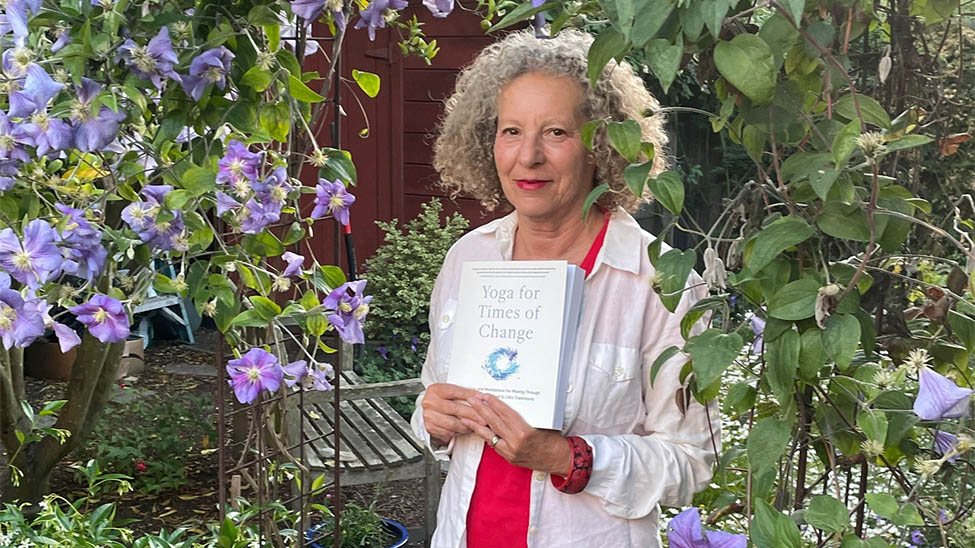

Introduction
Today we’re talking to Nina Zolotow, a yoga teacher and author of the book “Yoga for Times of Change: Practices and Meditations for Moving Through Stress, Anxiety, Grief & Life’s Transitions”. She is an expert in a wide variety of ways yoga can help you reach a state of deep relaxation, which is why we’re very excited about this interview. But enough of the introductory words, let’s let Nina speak for herself with our first question.
1. What inspired you to write the book Yoga for Times of Change: Practices and Meditations for Moving Through Stress, Anxiety, Grief & Life’s Transitions?
I originally trained to be a yoga teacher almost twenty years ago because I realized how much yoga was helping me personally with stress and anxiety. It is no exaggeration to say that yoga practice changed my life because it gave me tools that I could use at home to balance myself—to calm, energize, or uplift myself—any time I needed it. So, I really wanted to share what I had learned with as many other people as possible. And that’s why I started began teaching and blogging about stress, anxiety, depression, and cultivating equanimity.
Then, a few years ago, my editor at Shambhala Publications approached me about writing a new book for them. I seized the opportunity because at long last I had the chance to bring together all the work I’d been doing for the last twenty years into a single, complete resource. I actually got the book contract for a book on yoga for adapting to and accepting change in April 2020 at the beginning of the pandemic, and I poured my whole heart and soul into writing it.
Benefits of relaxation
You focus quite a bit on relaxation in this book. How can relaxation help with stress, anxiety, grief, and life’s transitions?
Spending time in a state of relaxation is very important for our mental as well as physical health. When we are in relaxation mode, which is called the Rest and Digest state, our bodies use that time not only to rest from exertion but also to restore and heal our bodies and minds. On the other hand, if we’re chronically stressed and never spend time in a state of conscious relaxation (as opposed to sleeping), being constantly alert for possible danger can actually cause problems like insomnia, anxiety, and depression.
This is why practicing yoga’s relaxation techniques on a regular basis when you’re going through a period of stress, anxiety, depression, anger, or grief or just through a challenging life transition can help you stay calmer, sleep better, think more clearly, and even prevent panic attacks. And practicing conscious relaxation regularly during less challenging times can help you maintain your balance when challenges do arise because your baseline stress levels are lower to start with and you have tools to help you stay that way.
In your book Yoga for Healthy Aging, you also focused quite a bit on relaxation. How can relaxation help with physical health and promote healthy aging?
Chronic stress can cause many physical problems, such as heart disease, hypertension (high blood pressure), insomnia and/or fatigue, digestive disorders, and weakened immune system. So lowering your stress levels by regularly practicing yoga’s relaxation techniques can help you reduce your risk of developing certain age-related diseases. And using yoga to cultivate equanimity can help you accept the changes that aging brings with more grace.
Yoga and relaxation
What is the relationship between yoga and relaxation? What are some of the yoga techniques for relaxing that you recommend?
Yoga was originally developed to help quiet the mind and enable the practitioner to weather the ups and downs of life with more equanimity. That’s why the yoga tradition includes a wide range of very effective techniques for relaxing mentally as well as physically. When you are in a state of relaxation, your racing mind slows down, and you can experience a deep sense of inner peace.
Some of the classic methods include:
Relaxing Yoga Poses. Yoga includes two types of poses that were designed to be relaxing. Restorative yoga poses provide deep relaxation by supporting and relaxing your body. Supported inverted poses (where you are fully or partially upside down) move you into a state of relaxation by changing your relationship with gravity.
Yogic Breath Practices. Breath practices where you make your exhalation longer than your inhalation or even just the same length as your inhalation will slow your heart rate, which in turn quiets your nervous system and take you into a state of relaxation.
Concentration Practices. These practices include concentration meditation, guided meditation or relaxation, and Relaxation pose (Savasana). All these practices that you into a state of relaxation because you focus your mind internally on something that isn’t stressful to you.
How can practicing these forms of relaxation help people in their everyday lives?
You can’t remove stress from your life. After all, even at its best, life is like that American ice cream flavor Rocky Road, full of bumps (nuts) as well as sweet surprises (marshmallows). So even if you don’t suffer from anxiety, depression, anger or a constant feeling of being “stressed out,” practicing relaxation on a regular basis can make you calmer overall and help you stay balanced when you do encounter those bumps in the road.
Yoga for starters
For someone who has never done any yoga at all, which practices do you suggest they start with?
Basically, keep it really simple. You can start with a single pose or practice. Just make sure you find the pose or practice that’s right for you based on what feels most effective and enjoyable for you personally. So, if the first thing you try doesn’t work for you, try something else!
Working with your breath can be an easy and effective way to start practicing yoga for relaxation, either with simple breath awareness or extending the exhalation. Practicing for 10 to 15 minutes will trigger the relaxation response.
But not everyone feels comfortable focusing on the breath. And for some a physical pose can be more relaxing.
So, for some beginners, practicing a single supported inverted pose, such as Legs Up the Wall pose (Viparita Karani)—which can be done with bent legs supported on a chair as well as with straight legs supported by a wall—can be an excellent place to start.
Other beginners may find that doing a single restorative pose, such as Reclined Cobbler’s pose (Supta Baddha Konasana) or even a simple Relaxation pose (Savasana), for around 10 minutes provides a combination of physical and mental relaxation.
Where can people find more information about these relaxation practices?
All of these relaxation practices and more are described in detail in my recent book Yoga for Times of Change as well as in the book Yoga for Healthy Aging, which has been translated into German. Both books also have simple yoga sequences you can practice as well. You can also find a ton of free information about practicing yoga for stress management on my blog Yoga for Healthy Aging at https://www.yogafortimesofchange.com/.
There are also many excellent books out there that explore yoga techniques for relaxation in depth, such as books on meditation, guided relaxation, pranayama (the breath practices), and restorative yoga.
I hope you all find one or two relaxation poses or practices that you find helpful—that can be life changing!








